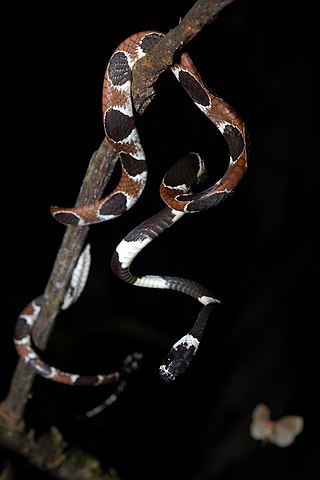
Dipsas variegata, the variegated snail-eater, is a snake found in South America. It is reported to feed almost exclusively on tree snails and slugs.

Sibon nebulatus, commonly known as the cloudy snail-eating snake, is a species of small, slender arboreal snake which is found in southern Mexico, Central America, northern South America, Isla Margarita, and Trinidad and Tobago.

Dipsas indica, also known as the neotropical snail-eater, is a snake species found in South America. It feeds on slugs and snails, which the snake can extract from their shells using its slender jaw.

Dipsas is a genus of nonvenomous New World snakes in the subfamily Dipsadinae of the family Colubridae. The genus Sibynomorphus has been moved here. Species of the genus Dipsas are known as snail-eaters.

The graceful snail-eater, is a non-venomous snake found in the northern part of South America . No subspecies are currently recognized.

Catesby's snail-eater, also commonly known as Catesby's snail sucker, is a nocturnal species of nonvenomous snake in the family Colubridae. The species is native to northern South America.

The Trinidad dog-like bat is a species of bat from the family Emballonuridae. It is native to Aruba, French Guiana, Grenada, Trinidad and Tobago, and Venezuela. The bat is considered to be rare everywhere in its geographic range, although this may be untrue, as the Trinidad dog-like bat was previously confused with the lesser dog-like bat. It is an aerial insectivore that roosts in hollow trees, hollow rotten logs on the ground, under overhanging banks, and caves in the Llanos of Venezuela.
Dipsas pakaraima is an arboreal snake of the family Dipsadidae. It has been placed in the Dipsas temporalis group. It is native to medium and higher elevations in west-central Guyana. It has been collected in Kaieteur National Park and Mount Ayanganna. Its food probably consists of snails and slugs.
Dipsas pratti, known commonly as Pratt's snail-eater, is a species of arboreal snake in the subfamily Dipsadinae of the family Colubridae. The species is endemic to northern South America.

The two-colored snail-eater, is a non-venomous snake found in Honduras, Nicaragua, and Costa Rica.

The snail-eating thirst snake or short-faced snail-eater is a non-venomous snake found in Mexico, Belize and Guatemala. Its length for male is approximately 373 mm and for female 357 mm,. They are oviparous in nature.
Dipsas gaigeae, also known commonly as Gaige's thirst snail-eater, Gaige's thirst snake, and zicatlinán in Mexican Spanish, is a species of non-venomous snake in the family Colubridae. The species is endemic to Mexico.
The Ecuador snail-eater is a non-venomous snake found in Ecuador..
Dipsas peruana, the Peruvian snail-eater or Peru snail-eater, is a non-venomous snake found in Peru, Venezuela, and Colombia, Ecuador, and Bolivia.
Dipsas schunkii, Schunk's snail-eater, is a non-venomous snake found in Peru.
Dipsas temporalis, the temporal snail-eater, is a non-venomous snake found in Panama, Ecuador, and Colombia.
Dipsas tenuissima, Taylor's snail-eater, is a non-venomous snake found in Panama and Costa Rica.
Dipsas vermiculata, the vermiculate snail-eater, is a non-venomous snake found in Ecuador, Peru, and Colombia.
Dipsas viguieri, Bocourt's snail-eater, is a non-venomous snake found in Panama, and Colombia.








